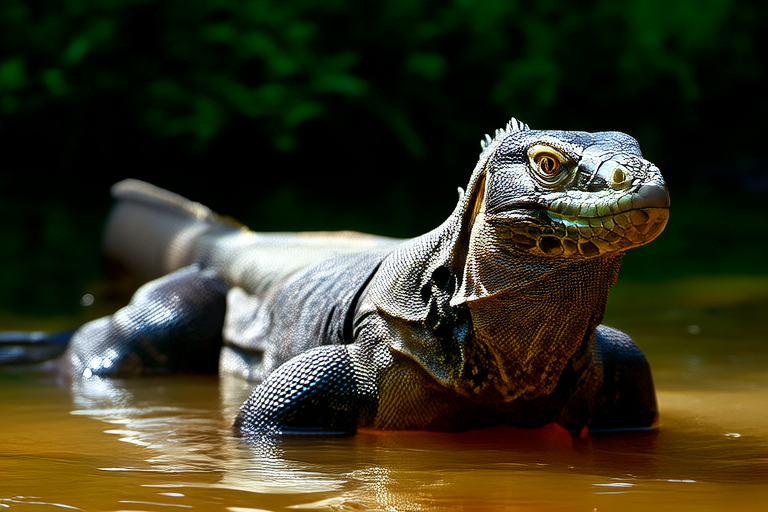Meet the Aquatic Wonder: The Thrilling World of Water Monitors
The world of reptiles is vast and diverse, but one species stands out for its remarkable aquatic prowess and adaptability: the water monitor (Varanus salvator). These creatures, native to Southeast Asia, are among the largest lizards in the world, and their ability to thrive both on land and in water makes them a subject of fascination for wildlife enthusiasts and researchers alike. Let us dive into the thrilling world of water monitors, exploring their unique characteristics, behaviors, and the challenges they face in the wild.
Physical Features and Adaptations
Water monitors are unmistakable due to their impressive size and striking appearance. Adult males can reach lengths of up to 3 meters (9.8 feet), with females being slightly smaller. Their bodies are long and slender, covered in smooth, scaly skin that ranges from olive green to brown, often with yellow or cream markings. This coloration helps them blend into their surroundings, providing excellent camouflage against predators.
One of the most notable features of water monitors is their powerful tail, which serves multiple purposes. It acts as a rudder when swimming, propelling the lizard through the water with swift, snake-like movements. On land, the tail provides balance and can be used as a defensive weapon. The water monitor’s claws are also highly adapted for climbing trees and gripping onto slippery surfaces, allowing it to navigate both terrestrial and aquatic environments with ease.
Dietary Preferences
Water monitors are opportunistic feeders with a diet that varies based on availability. Their primary food sources include fish, frogs, crabs, and other small vertebrates. They are known to hunt both on land and in water, using their keen sense of smell and sharp eyesight to locate prey. In addition to live animals, water monitors will consume carrion, making them important scavengers in their ecosystems. Their strong jaws and sharp teeth enable them to tackle larger prey items, contributing to their reputation as formidable hunters.
Habitat Preferences
Water monitors are highly adaptable and can be found in a variety of habitats throughout Southeast Asia, including mangrove swamps, rivers, lakes, and coastal areas. They prefer environments with abundant water sources, as these provide both hunting grounds and escape routes from potential threats. Despite their aquatic capabilities, water monitors are equally at home on land, where they can seek refuge in burrows or climb trees to avoid danger.
Their adaptability extends beyond just their choice of environment; water monitors can survive in a wide range of conditions, from freshwater to saltwater. This versatility allows them to inhabit diverse regions, from densely forested areas to open grasslands near water bodies. However, human activities such as deforestation and pollution have begun to encroach upon their natural habitats, posing significant threats to their survival.
Behavioral Traits
Water monitors are active during the day, spending much of their time basking in the sun to regulate their body temperature. When not basking, they are constantly on the move, searching for food or exploring new territories. Their agility in both water and on land allows them to traverse large distances in search of resources, making them efficient hunters and scavengers.
Despite their solitary nature, water monitors exhibit complex social behaviors. Males are territorial and will engage in combat with rivals over mating rights or prime hunting grounds. These confrontations involve head-butting and biting, with the victor establishing dominance. Females, on the other hand, tend to be more passive, focusing on finding suitable nesting sites for laying eggs. Once laid, the eggs are left unattended, relying on the warmth of the environment to incubate.
Conservation Efforts and Challenges
Despite their widespread distribution, water monitors face numerous challenges in the wild. Habitat destruction due to deforestation, urbanization, and agricultural expansion has led to a decline in suitable living spaces. Additionally, overhunting for their meat, skin, and traditional medicine has further reduced their populations. As a result, several subspecies of water monitors are now listed as vulnerable or endangered by the International Union for Conservation of Nature (IUCN).
To address these issues, various conservation efforts have been initiated. Protected areas and national parks have been established to safeguard remaining habitats, while captive breeding programs aim to boost population numbers. Education campaigns targeting local communities emphasize the importance of conserving water monitors and their ecosystems, fostering a sense of responsibility and stewardship.
Why Water Monitors Are Fascinating
Water monitors are not only remarkable for their physical attributes and behaviors but also for the insights they provide into evolutionary biology. Their ability to thrive in both aquatic and terrestrial environments showcases the incredible adaptability of reptiles, challenging preconceived notions about the limitations of specific animal groups. For wildlife enthusiasts, these creatures offer a glimpse into the intricate web of life that exists within our planet’s ecosystems.
Moreover, water monitors play crucial roles in maintaining ecological balance. As apex predators, they help control populations of smaller animals, preventing overgrazing and ensuring healthy ecosystems. By protecting their habitats, we not only preserve these magnificent lizards but also contribute to the overall health and diversity of our planet’s biodiversity.
The Importance of Preserving Natural Habitats
The story of water monitors highlights the interconnectedness of all living beings and underscores the importance of preserving natural habitats. Each species, no matter how small or seemingly insignificant, contributes to the delicate balance of life on Earth. By supporting conservation initiatives and advocating for sustainable practices, we can ensure that future generations have the opportunity to witness the wonders of creatures like the water monitor.
In conclusion, the water monitor is a true aquatic wonder, embodying the spirit of adaptation and resilience. Its unique characteristics, behaviors, and ecological significance make it a captivating subject for exploration and study. As stewards of our planet, it is our responsibility to protect these remarkable creatures and the habitats they call home, ensuring that the thrill of discovering such marvels continues for years to come.
